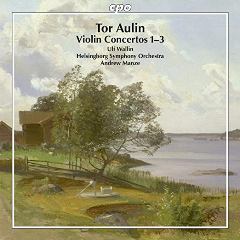Tor Aulin - Violin Concerts 1 - 3 (2018)
Tor Aulin - Violin Concerts 1 - 3 (2018)

1.Concert Piece for Violin & Orchestra op. 7 in G minor 19'46 [Violin Concerto No. 1] - Moderato – Un poco più tranquillo – Più animato – Andantino – Cadenza – Tempo I Violin Concerto No. 2 op. 11 in A minor 24'08 2.Moderato – attacca 9'45 3.Andante sostenuto 7'18 4.Allegro vivace 7'05 Violin Concerto No. 3 op. 14 in C minor 32'24 5.Molto moderato 12'10 6.Andante con moto 7'42 7.Finale: Allegro molto 12'32 Ulf Wallin - Violin Helsingborg Symphony Orchestra Andrew Manze - conductor
For decades after his death Aulin was largely represented on disc by only a few recordings of his ever-charming Aquarelles. Not even that fine Swedish soloist and chamber player Charles Barkel was granted the opportunity to record one of the three concertos, though a broadcast performance of the slow movement of the Third Concerto has emerged in recent years (see review). Fortunately players such as Arve Tellefsen (No.3 on LP) and Tobias Ringborg, on Sterling, and have made contributions to Aulin’s concerto and concertante literature on disc.
Now Ulf Wallin has changed the landscape with his set of three concertos with the Helsingborg Symphony under erstwhile fiddler Andrew Manze. And let me just say that, for all the occasional Leipzig-noodling to be found along the way, these are thoroughly persuasive and personable performances that respect Aulin’s imperishable gift for romantic lyricism and reverie.
The Concert Piece is, in effect, the First Concerto. Though some of the passagework sounds a little generic there are strong hints of Mendelssohn as well as inherent Nordic melodic beauty. As he was a distinguished soloist in his own right, one would expect idiomatic writing for the soloist but there are also elegant and attractive orchestral counter-themes to bolster the musical argument and this is a fully integrated work with a strong tranquillo nature, albeit a grossly overlong cadenza. Perhaps there are reminiscences of Beethoven’s own Concerto and of Bruch’s precedent too, all of which is unsurprising as he played most of the major concertos during his concert-giving career.
Beguiling lyricism floods the Second Concerto of 1892, its occasional attaca elements finely fused to the rhetorical argument and not overbalancing the essential relaxed nature of the writing. Aulin must have been a fine exponent of legato phrasing, as he premiered this work and wrote a seamless song without words as the central movement that he contrasts with a capricious sprite-like dance in the finale; a real Humoresque, splendidly negotiated in this performance. Formally speaking however, the Third Concerto is probably the most imposing. Printed in Leipzig and dedicated to Henri Marteau it opens with a rhapsodic cadenza and thenceforth operates on a Bruchian ground plan. With some welcome dramatic writing and a typically scena-like and ravishingly beautiful central movement this again reflects Aulin’s skillful manipulation of soloistic and orchestral writing.
These fine performances – possibly the end of the Concert Piece could have done with a retake - are well recorded and have attractive notes. Aulin broke no boundaries but lack of innovation is no bar to enjoying heartfelt lyrical music. ---Jonathan Woolf, musicweb-international.com
download (mp3 @320 kbs):
